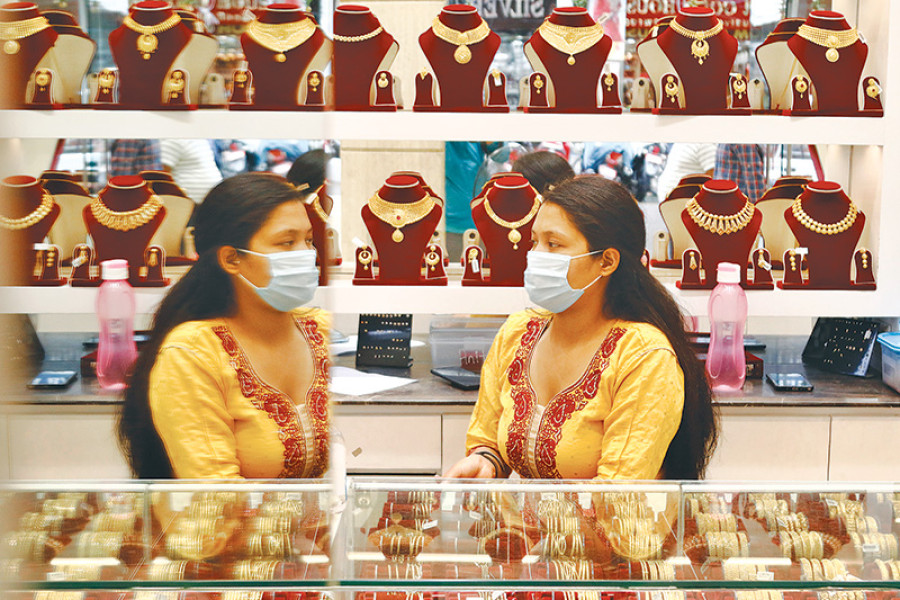Money
Falling prices drive demand for gold but officials say no to increasing import quota
Prices are expected to go down but increasing the quota could dent foreign currency reserves, central bank officials say.
Krishana Prasain
With an increase in demand for gold while the supply quota remains the same in the domestic bullion market, consumer rights activists and traders say black marketing has been observed in the past few weeks.
However, Nepal Rastra Bank says there is no significant reason to increase the import quota as it is the off-season for gold. Demand for the precious metal is high in the wedding season but since economic activity has slowed down as a result of the Covid-19 pandemic, officials say the demand is low.
“There should be a reason to justify the increase in import quotas,” Gunakar Bhatta, spokesperson for the Nepal Rastra Bank said. “If there is a valid reason for the increase in demand, then government agencies will discuss it to increase the quota.”
The central bank slashed the daily import quota of gold from 20 kilos to 10 kilos in March last year expecting the pressure in foreign exchange reserves due to the pandemic.
Contrary to expectations, gold import has jumped 66 percent in the first seven months of the current fiscal year due to a rise in demand with declining prices, domestic bullion traders say.
According to the Trade and Export Promotion Center, the country imported gold worth Rs15 billion in the first seven months of the current fiscal year, up from Rs9 billion during the same time last fiscal year. The country imported gold worth Rs13.63 billion in the fiscal year 2019-20.
Tej Ratna Shakya, former president of the Federation of Nepal Gold and Silver Dealers’ Association, said daily demand has increased to around 20 kilos while the supply has declined since March last year.
According to the Department of Customs, the import quantity has also increased from 1,684 kgs in the first seven months of the fiscal year 2019-20 to 2,109 kilos in the same period of 2020-21.
“With supply not meeting the demand, the bullion market is witnessing black marketing in recent times,” Shakya told the Post. “It is heard that bullion traders have started hiking the price by Rs2,000 to Rs3,000 per tola [11.6638 grams] than the daily price set by the federation.”
Consumer rights activists said that opportunist traders tend to increase the price with the problem in demand and supply and to stop it the demand needs to be fulfilled.
Madhav Timalsina, president of the Consumer Rights Investigation Forum, said that after not getting the gold as demanded, traders say they are buying it in black market and this has affected the price for the past few weeks.
“Nepal Rastra Bank should take an initiative immediately to increase the import quota as per the demand and supply trend,” said Timalsina.
An official at the central bank said there is no reason to increase the import quota immediately as there is no reason to buy for personal use till mid-April.
“The demand can increase from mid-April [Baisakh] and by observing the foreign exchange level, the quota can be increased,” he said on condition of anonymity. “But as the fuel price is increasing in the international market, this can create pressure on foreign exchange reserves in the coming days.”
Representatives of the Federation of Nepal Gold and Silver Dealers’ Association met with the secretary of the Ministry of Industry, Commerce and Supplies a few weeks ago, requesting an increase in daily import quota of gold. The ministry responded that it will coordinate with the central bank to increase the quota, according to Shakya.
“The governor had also said the import quota would be increased soon but it has not happened so far,” Shakya told the Post.
But with the change in the commerce secretary, traders have not heard anything since.
The gold price increased from Rs64,000-65,000 per tola in the first month of the fiscal year 2019-20 to Rs73,000 to Rs74,000 in mid-February of the fiscal year. Due to the sudden hike in prices demand had fallen, according to traders.
Another reason for the increase in demand now is that people have started buying gold for the upcoming wedding season that starts in mid-April, according to traders.
The bullion price reached a record high of Rs103,500 per tola in mid-July last year and gradually started to decline reaching Rs88,800 per tola on Friday. The price has declined by around Rs15,000 in seven months and the falling price trend pushed the demand, Shakya said.
“Prices have reached all-time high and demand also slowed down, hitting almost zero due to the lockdown before Dashain and Tihar,” said Shakya. “But the demand started to rise with the festival.”
Domestic bullion traders expect there will be a gradual fall in prices in the coming days going by the international market.
According to Shakya, new US president Joe Biden is planning new alternative energy projects. Since solar power equipment needs silver, the demand for metal is expected to rise. People therefore have started investing in silver by selling gold.
The vaccination programme in the US and stimulus packages and also plans to improve relations with China will cause further decline in gold prices.
Gold traded at $1,735 per ounce on Saturday and is expected to decline to $1,700 per ounce, which means the price is expected to decline to around Rs85,000 per tola in the Nepali market soon, Shakya said.
Meanwhile, Nepali investors are prioritising gold as a safe haven to invest to keep up the purchasing power. As a result, the demand is increasing with uncertainty in the market, economic slowdown and inflation, traders say.




 12.88°C Kathmandu
12.88°C Kathmandu















